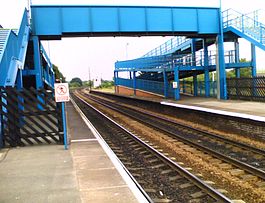Barnetby railway station
| Barnetby |
|
|---|---|

Pedestrian bridge over platforms
|
|
| Location | |
| Place | Barnetby-le-Wold |
| Local authority | North Lincolnshire |
| Coordinates | 53°34′30″N 0°24′36″W / 53.57503°N 0.40990°WCoordinates: 53°34′30″N 0°24′36″W / 53.57503°N 0.40990°W |
| Grid reference | TA053098 |
| Operations | |
| Station code | BTB |
| Managed by | TransPennine Express |
| Number of platforms | 4 |
| DfT category | F1 |
| Live arrivals/departures, station information and onward connections from National Rail Enquiries |
|
| Annual rail passenger usage* | |
| 2011/12 |
|
| – Interchange |
|
| 2012/13 |
|
| – Interchange |
|
| 2013/14 |
|
| – Interchange |
|
| 2014/15 |
|
| – Interchange |
|
| 2015/16 |
|
| – Interchange |
|
| History | |
| Key dates | Opened 1849 |
| National Rail – UK railway stations | |
| * Annual estimated passenger usage based on sales of tickets in stated financial year(s) which end or originate at Barnetby from Office of Rail and Road statistics. Methodology may vary year on year. | |
|
|
|
Barnetby railway station serves the village of Barnetby-le-Wold in North Lincolnshire, England. It is operated by TransPennine Express, with East Midlands Trains and Northern also serving the station.
Barnetby railway station is unstaffed, and is popular with railway enthusiasts for the freight which passes through.
The railway first came to Barnetby in 1848 when the Great Grimsby and Sheffield Junction Railway was constructed. This line ran from Sheffield, through Retford, Torksey, Lincoln and Market Rasen before reaching Barnetby – then on to Grimsby. A year later, and the section of route between Gainsborough and Barnetby was opened, thus establishing the villages future as a railway centre. The most important connection – and still is to this day, was the building of the Trent, Ancholme and Grimsby in 1866 – through the steel town of Scunthorpe. Over the following years, these railways – and several others became part of the Great Central Railway.
The Great Central Railway recognised the importance of the Humber ports. As well as developing Grimsby, the company invested heavily in Immingham Docks. Immingham was unique among the Humber ports in that a deep water channel made easy access for ships at all states of the tide. This suited the Great Central Railway as one of its chief forms of traffic was coal from the South Yorkshire and East Midlands coal-fields.
With the increased traffic through Barnetby, the track infrastructure needed more investment. At the time, Barnetby had a fairly simple layout based on a standard double track. It even had a level crossing near to where the Kings Road bridge is today. To make passage easier, the Great Central Railway invested in the quadrupling of the track between Wrawby Junction and Brocklesby Junction – together with much improved signalling. The level crossing was removed and the Kings Road underbridge was built. To handle the traffic, new signal boxes were built at Wrawby Junction, Barnetby West, Barnetby East, Melton Ross and Brocklesby Junction.
...
Wikipedia
